How we can help your Eczema
At DigiDerm we know how frustrating it is to suffer with skin conditions and how easy it is to get lost in all the information out there on the internet. We’ve put together this guide to give you all you need to know about eczema and most importantly how you can manage your eczema and get back to doing the things you love without it getting in the way!
DigiDerm is run by practicing NHS clinicians and we pride ourselves on providing you the best evidence based care. If you know what you need then you can go straight to our treatments (and select what you need.
If you’re not sure what you need then we’ve put together some info below to help you find out more about eczema and what treatment is right for you. If you’re still not sure at the end then don’t hesitate to book a telephone or video consultation with one of our clinicians. We would be happy to help with any questions and if we can’t help, you won’t pay a penny. We’ll follow you up to check everything’s working as it should be and make sure you get the right treatments for your eczema.
Make sure to check out our FAQs section at the end which has some of the most common questions we get about eczema.
Firstly there are multiple types of eczema. The most common form is known as atopic dermatitis or atopic eczema but there are 7 types of eczema in total. These include:
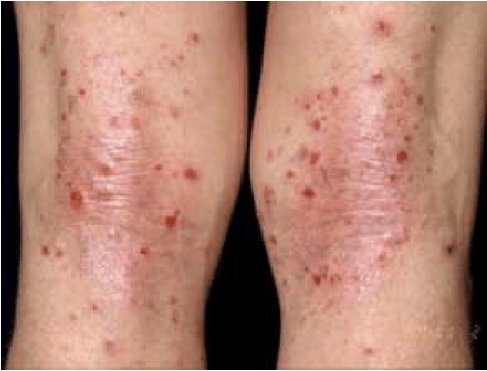
Atopic Dermatitis/Atopic Eczema
Atopic eczema causes, red, itchy and dry patches of skin. Atopic basically means prone to allergies and for this reason atopic eczema is thought to be a form of allergic reaction. It is more likely to occur in people who also suffer with hay fever or asthma although this is not always the case. It also frequently first occurs in childhood so you may have been suffering from it for a long time.
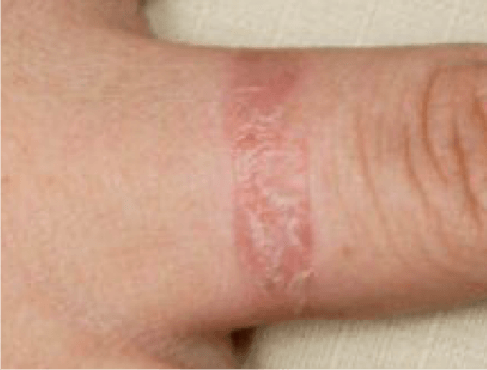
Contact Dermatitis
Contact dermatitis is caused by an allergic reaction to a substance that the body has had prolonged exposure to. This can be caused by a number of different items such as: jewellery, belt buckles, metal zips, hair dye, etc. The image above shows a contact dermatitis reaction caused by a ring.
Contact dermatitis is common in individuals who are in regular contact with chemicals as part of their profession such as healthcare workers or mechanics.
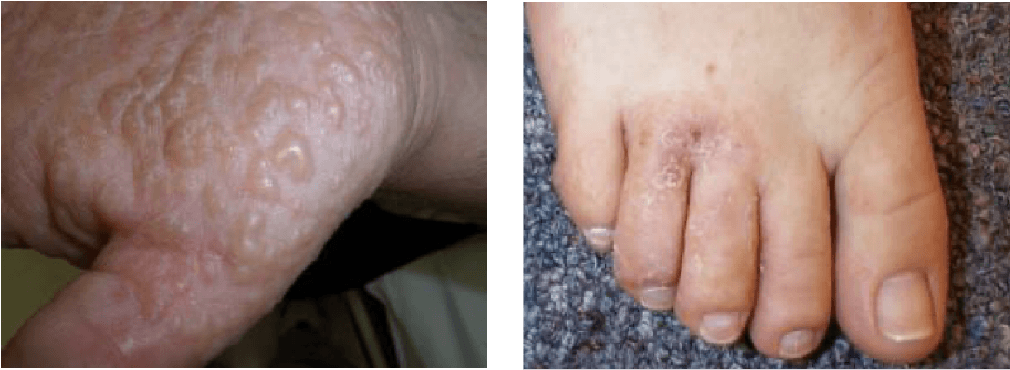
Dyshidrotic (Pompholyx) Eczema
Dishydrotic or Pompholyx eczema causes bubbly itchy blisters that most commonly occur on the palms of the hands or soles of the feet. They can also occur around the toes and fingers. This form of eczema tends to run in families and is most common in people who already have another form of eczema.
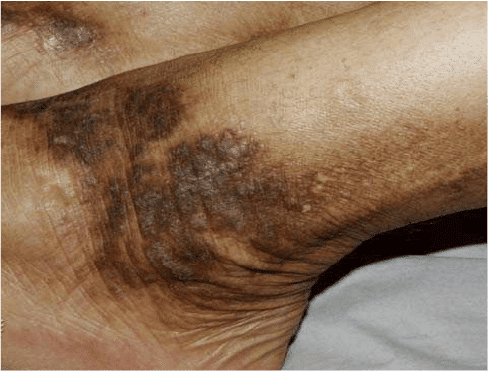
Neurodermatitis (Lichen Simplex)
Neurodermatitis or Lichen Simplex tends to affect individual patches of skin and occurs as a result of intense itching of those areas which leads to thickening and discolouration of these areas of skin.
Over time intense itching can damage the nerve endings and lead to further itching and discomfort as a result.
This form of eczema is more common in people that already suffer with other forms of eczema and can be more common in people that suffer with anxiety conditions.
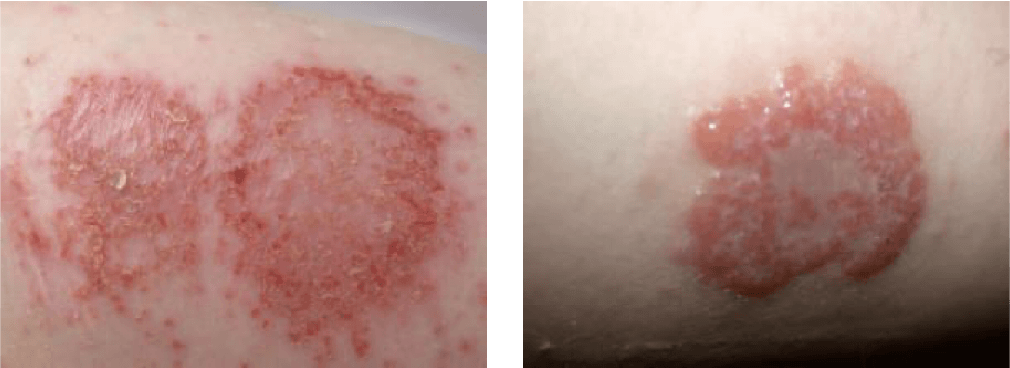
Discoid (Nummular Eczema)
Discoid or Nummular Eczema appears as numerous round lesions of itchy, irritated skin. These can appear as red, pink or brown in colour.
This form of eczema can be mistaken for other skin conditions such as ringworm or psoriasis so if you have not been formerly diagnosed it is worth having a discussion with one of our experts to confirm the diagnosis. Make an appointment here.
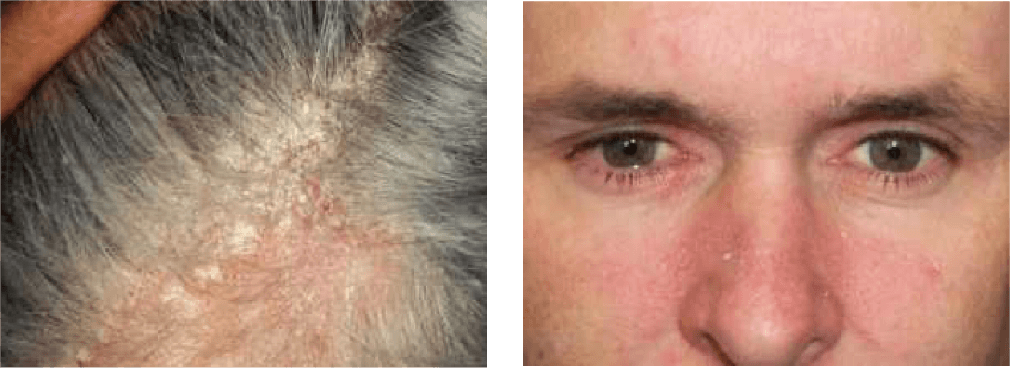
Seborrheic Dermatitis
Seborrheic dermatitis is often associated with the scalp however it can occur anywhere on the body with lots of oil producing glands. These are called sebaceous glands and there are lots of these on your nose, upper back and scalp which is why these areas tend to be affected.
If this is on your face then you need to be extra careful when applying steroid creams, as this area of skin is more sensitive and you shouldn’t apply anything more than moderate strength steroid to this area. If you’ve never used steroids on your face before make sure to chat through with one of our experts. Make appointment here.
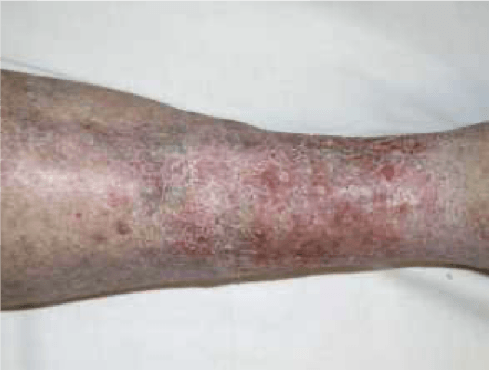
Varicose (Venous) Eczema
Varicose eczema occurs on the lower legs and is caused by fluid build-up, as a result of poor circulation.
This type of eczema is most likely to occur after the age of 50 and can signal other health conditions such as heart failure or high blood pressure. If you think you have this form of eczema it’s worth seeing your GP if you haven’t already, so they can check you over.
More about Eczema
Eczema tends to have periods of time when it is fairly inactive but then have periods in which it flares causing itching, sensitivity and inflamed skin.
The treatment of eczema tends to be broken down into two main steps. These include using steroid creams short term to manage flares and using emollients to manage the dry skin often associated with eczema.
Through keeping the skin moisturised effectively we can reduce the amount you need to use steroid creams and the amount of flares you have so it is important to continue to use them regularly even if your eczema is under control however moisturisers are unlikely to have much effect on an active flare of eczema and steroids are usually the best treatment option for these flares. Take care to always apply steroids thinly and only for short periods of time. One week is usually enough for most people.
Unfortunately there isn’t one simple cause for eczema. It can be caused by a variety of factors which we will discuss below:
Genetics- There is likely a genetic component to eczema and this is why it often runs in families.
Studies have linked eczema to a deficiency in a protein called fillagrin. This is responsible for forming a healthy barrier on the skin and not having enough fillagrin can cause people to have dry and flaky skin more prone to eczema.
Allergies- Whilst the exact cause of eczema is not known it is thought to be related to an overactive immune system and can be made worse by certain triggers that cause the immune system to react. Many of these triggers can come from regular household items such as: washing up liquid, soaps and detergents, etc. Other allergies such as dust mites, pet fur and many more can also cause it to flare. Sometimes we can identify what these triggers are and if you can eliminate them from your day to day life, this can help to manage your eczema.
Food allergies- Certain foods are also thought to play a role in some people. Keeping a food diary and making note of when your eczema is at its worst can help you to identify certain trigger foods for you.
Other triggers are also thought to play a role in certain people such as the weather and stress.
In summary there are lots of triggers and different people will find different things make their eczema worse. It is worth thinking about what some of your triggers might be and avoiding these where possible.
In a nutshell:
• Greasy skin
• Blackheads and Whiteheads (Comedones)
• Larger red inflamed spots with pus (Papules and Pustules)
• Scarring (In moderate to severe disease)
Acne can appear slightly differently in different people- most people will have greasy skin which usually affects the face but can also occur commonly on the back and chest. At the milder stage it can present as blackheads and whiteheads (little pimples under the surface of the skin from blocked pores). As acne progresses in severity it can lead to inflamed red spots (known as papules) and spots containing pus (pustules). The most severe forms of acne can include deep red painful large spots called cysts- these are best assessed by a consultant dermatologist in a hospital setting. In some cases acne may also lead to scarring which can either be atrophic (loss of tissue) or hypertrophic (increase of fibrous tissue) scars- there is more information below in the FAQs about acne scarring and how to manage it.
Eczema is usually not too complicated to diagnose and presents fairly typically with red, inflamed, dry and irritated skin. It is most common to occur in childhood so the chances are you have known or suspected you have eczema for a while. If you are in any doubt about what you have then feel free to book a consultation with one of our clinicians and we would be more than happy to help, get in touch here.
Eczema Examples
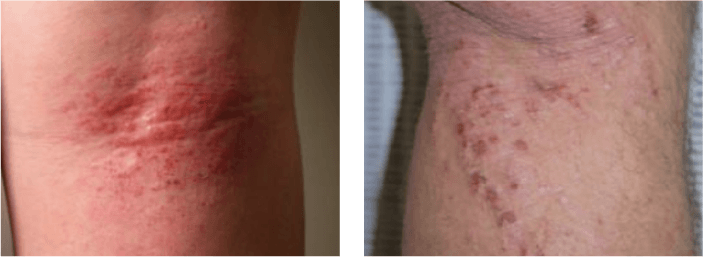
The images above show typical eczema. As in the above images eczema is most likely to occur flexural areas. This means where there are bends in the body that result in skin rubbing together frequently. Most commonly this occurs at the flex of the elbows or knees.
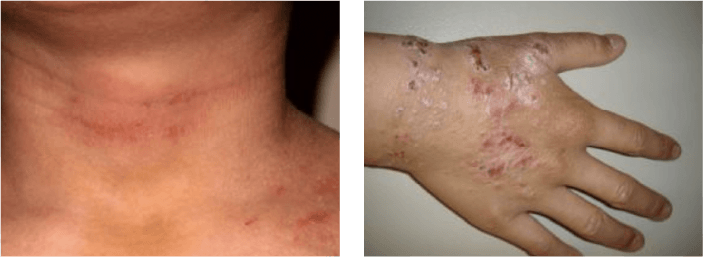
Eczema can also occur in other areas of the body such as the hands and neck as seen above.

It’s important to realise that eczema doesn’t look the same in all skin tones. On darker skin tones, eczema can often appear darker like the image above.
NOTE: Don’t worry if you are unsure of what treatments to select. You can start a simple online questionnaire-based consultation, attach some photos, and we will let you know if the treatment you have selected is safe and appropriate- if not, we will recommend an alternative. If you’d prefer to talk over the phone, you can book in for a telephone or video consultation with one of our friendly dermatology specialists and we can recommend suitable treatments and advice.
Here are some of the treatment choices that we offer for eczema in line with the latest clinical guidelines for dermatology in the UK (click on the product for more information and to start a consultation).
We will start with steroids. These are to be used when you have a flare of eczema. Make sure to apply them sparingly and usually for no longer than 7 days continuously unless advised by a clinician. They are a great way to settle down a flare of eczema but not a long term solution.
There are varying strengths of steroids from mild to very potent. If you already know what strength you need as you’ve had it before then this is likely to work for you again. If you have not tried steroid creams before it is worth being cautious and starting with a milder steroid, only using potent steroids on the advice of a clinician.
You should be particularly careful when applying steroid creams to sensitive skin areas such as your face or genitals. You shouldn’t apply steroids to these areas unless advised to do so by a clinician after assessment and you should never use anything more than moderate strength steroids in these areas.
We are happy to have a look at some pictures or speak on a video call to advise on what strength we think you need if you’re unsure, get in touch here.
Mild steroid creams:
Moderate Steroid Creams:
Potent Steroid Creams:
Very potent steroid creams:
e.g- Dermovate (clobetasol propionate 0.05%)
Emollients
The other major component of most eczema treatment is finding the right emollient.
Emollients form a protective barrier on the skin and block moisture from escaping. This prevents the skin from drying out and makes it less likely to become irritated and inflamed, as can often happen in eczema.
It is important to apply plenty of emollient and to do so regularly. Thicker ointments last for around 12 hours whilst creams, lotions and gels only tend to last around 8 hours which means you would need to apply these thinner preparations at least three times a day and ointment twice a day for optimal results.
Ointments are better at locking in moisture because they are thicker and more oily however because of their oily texture some people don’t like applying these as much, as they can remain visible on the skin for longer after being applied and can stick to clothing and bedding, etc. Creams, lotions and gels are generally better tolerated due to them being thinner and thus more easily absorbed by the skin but because of this they will not moisturise the skin as effectively as ointments. Some people choose to combine multiple emollients, such as a cream and an ointment by putting the cream on throughout the day and ointment at night.
If you are using a cream, lotion or gel and your skin is still dry it is worth considering if you are applying regularly enough and if so it might be worth trying a thicker preparation such as an ointment. We’ve put together an emollient guide below to help you choose the right emollient for you. This shows you the different types of emollients with the thinnest least moisturising lotions at the top and thickest most moisturising ointments at the bottom. The thinner lotions are good for people with mild eczema that is well controlled and just need a small amount of moisturiser to manage their symptoms, while the thicker ointments are useful for someone with extremely dry skin that is still dry after applying plenty of gels. See our guide below for more information about the various emollients we offer and find the best one for you.
Emollient Guide
Lighter less oily preparations
(Less moisturising)
Thicker more oily preparations
(More moisturising)
Ointments: Cetraben Ointment, Epaderm Ointment, Sebco Ointment.
Other preparations
Antibiotic Creams: Fucidin Cream, Fucidin H Cream, Fucibet Cream, Betamethasone with Neomycin Cream, Betamethasone with Clioquinol cream.
Antibiotic containing creams Should only be used where you are treating an active infection. They are for short-term use to treat the infection. Some of these also contain steroids to treat active flares of eczema at the same time.
Soap Substitutes: Cetraben Bath Additive, Dermol 200 Shower Emollient, CeraVe Hydrating Cleanser.
Soap substitutes are useful if soaps trigger your eczema however they are washed off quickly so will not moisturise the skin very effectively.
Antimicrobial Creams: Dermol Cream, Dermol 200 Shower Emollient, Dermol 500 Lotion, Hibiscrub Antibacterial Skin Cleanser.
Antimicrobial creams are useful if your eczema is often getting infected or if you are using the cream as a soap substitute.
Topical Calcineurin Inhibitors
These are specialist creams reserved to treat certain types of difficult to treat eczema. They include the creams Elidel (pimecrolimus) and Protopic (tacrolimus). They work by affecting the immune system, blocking it from reacting and stopping eczema flares.
These creams are particularly useful in patients with eczema in areas of sensitive skin such as the face or genitals, or in those that have experienced significant negative side effects from steroid creams. These creams are relatively new but are not thought to have the same negative side effects associated with steroid creams, such as skin thinning, so can be a better alternative in people that would otherwise require regular courses of steroids to treat eczema in sensitive areas of their skin.
These treatments are available here on DigiDerm but due to the specialist nature we may need to speak to you to make sure it’s the right treatment for you if you haven’t had it from us before. If you think you might need one of these creams find out more information here.
Phototherapy
This is where different wavelengths of UV light are used to treat eczema. This treatment is generally reserved for people where creams have failed and is offered in specialty dermatology clinics.
Immunosuppressant Tablets
Medications such as methotrexate, azathioprine, ciclosporin and mycophenolate mofetil can be initiated by a specialist. These reduce the body’s immune response and can improve eczema symptoms. You would need regular blood monitoring in order to take these medicines and so we are not able to start these medications at DigiDerm. You will need to see a dermatologist to discuss these treatments if you think you might need them.
Biologics
These are another class of immunosuppressant drugs that are given by injection. Like the tablets mentioned above they would need to be started by a dermatologist. Biologics used in eczema include Dupilumab (Dupixent) and Tralokinumab (Adtralza).
Make sure to moisturise regularly multiple times a day.
Use steroid creams when needed for flares but apply thinly and only for a maximum of 2 weeks at a time. 1 week is usually sufficient.
Try to identify triggers and avoid these wherever possible. This could be certain foods, soaps, clothing or detergents.
Antihistamines can be used to help with itching associated with eczema.
Heat can trigger eczema, so keep your house cool and try not to take very warm showers.
If you have dry skin despite moisturising regularly. You may not be using the right moisturiser. Thicker ointment moisturisers are better at locking moisture into the skin than thinner creams and lotions. Consider switching to one of our ointments and this should improve things.
Stress can cause eczema flares. It’s a busy life and sometimes stress can get on top of us. There is lots of help out there though, so try bringing down your stress levels and you may find this improves your eczema.

A Guide to Eczema
At DigiDerm we know how frustrating it is to suffer with skin conditions and how easy it is to get lost in all the information out there on the internet. We’ve put together this guide to give you all you need to know about eczema and most importantly how you can manage your eczema and get back to doing the things you love without it getting in the way!
DigiDerm is run by practicing NHS clinicians and we pride ourselves on providing you the best evidence based care. If you know what you need then you can go straight to our treatments (and select what you need.
If you’re not sure what you need then we’ve put together some info below to help you find out more about eczema and what treatment is right for you. If you’re still not sure at the end then don’t hesitate to book a telephone or video consultation with one of our clinicians. We would be happy to help with any questions and if we can’t help, you won’t pay a penny. We’ll follow you up to check everything’s working as it should be and make sure you get the right treatments for your eczema.
Make sure to check out our FAQs section at the end which has some of the most common questions we get about eczema.

What you need to know about Eczema
Firstly there are multiple types of eczema. The most common form is known as atopic dermatitis or atopic eczema but there are 7 types of eczema in total. These include:

Atopic Dermatitis/Atopic Eczema
Atopic eczema causes, red, itchy and dry patches of skin. Atopic basically means prone to allergies and for this reason atopic eczema is thought to be a form of allergic reaction. It is more likely to occur in people who also suffer with hay fever or asthma although this is not always the case. It also frequently first occurs in childhood so you may have been suffering from it for a long time.

Contact Dermatitis
Contact dermatitis is caused by an allergic reaction to a substance that the body has had prolonged exposure to. This can be caused by a number of different items such as: jewellery, belt buckles, metal zips, hair dye, etc. The image above shows a contact dermatitis reaction caused by a ring.
Contact dermatitis is common in individuals who are in regular contact with chemicals as part of their profession such as healthcare workers or mechanics.

Dyshidrotic (Pompholyx) Eczema
Dishydrotic or Pompholyx eczema causes bubbly itchy blisters that most commonly occur on the palms of the hands or soles of the feet. They can also occur around the toes and fingers. This form of eczema tends to run in families and is most common in people who already have another form of eczema.

Neurodermatitis (Lichen Simplex)
Neurodermatitis or Lichen Simplex tends to affect individual patches of skin and occurs as a result of intense itching of those areas which leads to thickening and discolouration of these areas of skin.
Over time intense itching can damage the nerve endings and lead to further itching and discomfort as a result.
This form of eczema is more common in people that already suffer with other forms of eczema and can be more common in people that suffer with anxiety conditions.

Discoid (Nummular Eczema)
Discoid or Nummular Eczema appears as numerous round lesions of itchy, irritated skin. These can appear as red, pink or brown in colour.
This form of eczema can be mistaken for other skin conditions such as ringworm or psoriasis (Link to psoriasis page) so if you have not been formerly diagnosed it is worth having a discussion with one of our experts to confirm the diagnosis. Make an appointment here.

Seborrheic Dermatitis
Seborrheic dermatitis is often associated with the scalp however it can occur anywhere on the body with lots of oil producing glands. These are called sebaceous glands and there are lots of these on your nose, upper back and scalp which is why these areas tend to be affected.
If this is on your face then you need to be extra careful when applying steroid creams, as this area of skin is more sensitive and you shouldn’t apply anything more than moderate strength steroid to this area. If you’ve never used steroids on your face before make sure to chat through with one of our experts. Make appointment here.

Varicose (Venous) Eczema
Varicose eczema occurs on the lower legs and is caused by fluid build-up, as a result of poor circulation.
This type of eczema is most likely to occur after the age of 50 and can signal other health conditions such as heart failure or high blood pressure. If you think you have this form of eczema it’s worth seeing your GP if you haven’t already, so they can check you over.
More about Eczema
Eczema tends to have periods of time when it is fairly inactive but then have periods in which it flares causing itching, sensitivity and inflamed skin.
The treatment of eczema tends to be broken down into two main steps. These include using steroid creams short term to manage flares and using emollients to manage the dry skin often associated with eczema.
Through keeping the skin moisturised effectively we can reduce the amount you need to use steroid creams and the amount of flares you have so it is important to continue to use them regularly even if your eczema is under control however moisturisers are unlikely to have much effect on an active flare of eczema and steroids are usually the best treatment option for these flares. Take care to always apply steroids thinly and only for short periods of time. One week is usually enough for most people.

What Causes Eczema?
Unfortunately there isn’t one simple cause for eczema. It can be caused by a variety of factors which we will discuss below:
Genetics- There is likely a genetic component to eczema and this is why it often runs in families.
Studies have linked eczema to a deficiency in a protein called fillagrin. This is responsible for forming a healthy barrier on the skin and not having enough fillagrin can cause people to have dry and flaky skin more prone to eczema.
Allergies- Whilst the exact cause of eczema is not known it is thought to be related to an overactive immune system and can be made worse by certain triggers that cause the immune system to react. Many of these triggers can come from regular household items such as: washing up liquid, soaps and detergents, etc. Other allergies such as dust mites, pet fur and many more can also cause it to flare. Sometimes we can identify what these triggers are and if you can eliminate them from your day to day life, this can help to manage your eczema.
Food allergies- Certain foods are also thought to play a role in some people. Keeping a food diary and making note of when your eczema is at its worst can help you to identify certain trigger foods for you.
Other triggers are also thought to play a role in certain people such as the weather and stress.
In summary there are lots of triggers and different people will find different things make their eczema worse. It is worth thinking about what some of your triggers might be and avoiding these where possible.

What are the Symptoms of Eczema?
In a nutshell:
• Greasy skin
• Blackheads and Whiteheads (Comedones)
• Larger red inflamed spots with pus (Papules and Pustules)
• Scarring (In moderate to severe disease)
Acne can appear slightly differently in different people- most people will have greasy skin which usually affects the face but can also occur commonly on the back and chest. At the milder stage it can present as blackheads and whiteheads (little pimples under the surface of the skin from blocked pores). As acne progresses in severity it can lead to inflamed red spots (known as papules) and spots containing pus (pustules). The most severe forms of acne can include deep red painful large spots called cysts- these are best assessed by a consultant dermatologist in a hospital setting. In some cases acne may also lead to scarring which can either be atrophic (loss of tissue) or hypertrophic (increase of fibrous tissue) scars- there is more information below in the FAQs about acne scarring and how to manage it.

How is Eczema Diagnosed?
Eczema is usually not too complicated to diagnose and presents fairly typically with red, inflamed, dry and irritated skin. It is most common to occur in childhood so the chances are you have known or suspected you have eczema for a while. If you are in any doubt about what you have then feel free to book a consultation with one of our clinicians and we would be more than happy to help, get in touch here.
Eczema Examples

The images above show typical eczema. As in the above images eczema is most likely to occur flexural areas. This means where there are bends in the body that result in skin rubbing together frequently. Most commonly this occurs at the flex of the elbows or knees.

Eczema can also occur in other areas of the body such as the hands and neck as seen above.

It’s important to realise that eczema doesn’t look the same in all skin tones. On darker skin tones, eczema can often appear darker like the image above.

What is the Best Treatment for Eczema?
NOTE: Don’t worry if you are unsure of what treatments to select. You can start a simple online questionnaire-based consultation, attach some photos, and we will let you know if the treatment you have selected is safe and appropriate- if not, we will recommend an alternative. If you’d prefer to talk over the phone, you can book in for a telephone or video consultation with one of our friendly dermatology specialists and we can recommend suitable treatments and advice.
Here are some of the treatment choices that we offer for eczema in line with the latest clinical guidelines for dermatology in the UK (click on the product for more information and to start a consultation).
We will start with steroids. These are to be used when you have a flare of eczema. Make sure to apply them sparingly and usually for no longer than 7 days continuously unless advised by a clinician. They are a great way to settle down a flare of eczema but not a long term solution.
There are varying strengths of steroids from mild to very potent. If you already know what strength you need as you’ve had it before then this is likely to work for you again. If you have not tried steroid creams before it is worth being cautious and starting with a milder steroid, only using potent steroids on the advice of a clinician.
You should be particularly careful when applying steroid creams to sensitive skin areas such as your face or genitals. You shouldn’t apply steroids to these areas unless advised to do so by a clinician after assessment and you should never use anything more than moderate strength steroids in these areas.
We are happy to have a look at some pictures or speak on a video call to advise on what strength we think you need if you’re unsure, get in touch here.
Mild steroid creams:
e.g- Hydrocortisone 1.0% ointment/cream
Moderate Steroid Creams:
e.g- Eumovate (clobetasone butyrate 0.05%) cream and Betnovate RD (betamethasone valerate 0.025%)
Potent Steroid Creams:
e.g- Betnovate (betamethasone valerate 0.1%)
Very potent steroid creams:
e.g- Dermovate (clobetasol propionate 0.05%)
Emollients
The other major component of most eczema treatment is finding the right emollient. Emollients form a protective barrier on the skin and block moisture from escaping. This prevents the skin from drying out and makes it less likely to become irritated and inflamed, as can often happen in eczema.
It is important to apply plenty of emollient and to do so regularly. Thicker ointments last for around 12 hours whilst creams, lotions and gels only tend to last around 8 hours which means you would need to apply these thinner preparations at least three times a day and ointment twice a day for optimal results.
Ointments are better at locking in moisture because they are thicker and more oily however because of their oily texture some people don’t like applying these as much, as they can remain visible on the skin for longer after being applied and can stick to clothing and bedding, etc. Creams, lotions and gels are generally better tolerated due to them being thinner and thus more easily absorbed by the skin but because of this they will not moisturise the skin as effectively as ointments. Some people choose to combine multiple emollients, such as a cream and an ointment by putting the cream on throughout the day and ointment at night.
If you are using a cream, lotion or gel and your skin is still dry it is worth considering if you are applying regularly enough and if so it might be worth trying a thicker preparation such as an ointment. We’ve put together an emollient guide below to help you choose the right emollient for you. This shows you the different types of emollients with the thinnest least moisturising lotions at the top and thickest most moisturising ointments at the bottom. The thinner lotions are good for people with mild eczema that is well controlled and just need a small amount of moisturiser to manage their symptoms, while the thicker ointments are useful for someone with extremely dry skin that is still dry after applying plenty of gels. See our guide below for more information about the various emollients we offer and find the best one for you.
Emollient Guide
Lighter less oily preparations
(Less moisturising)
Lotions: Aveeno Daily Moisturising Lotion, CeraVe AM Facial Moisturising Lotion, Cetraben Lotion, Dermol 500 Lotion.
Thicker more oily preparations
(More moisturising)
Ointments: Cetraben Ointment, Epaderm Ointment, Sebco Ointment.
Creams: Aveeno Cream, Aveeno Dermexa Cream, Balneum Cream, Balneum Plus Cream, CeraVe Moisturising Cream, CeraVe SA Smoothing Cream, Cetraben Cream, Cetraben Oatmeal Cream, Dermol Cream, Diprobase Cream, E45 Cream, E45 Dermatitis Cream, Epaderm Cream, Zerobase Cream
Gels: Adex Gel, Doublebase Dayleve Gel, Doublebase Gel.
Other preparations
Antibiotic Creams: Fucidin Cream, Fucidin H Cream, Fucibet Cream, Betamethasone with Neomycin Cream, Betamethasone with Clioquinol cream.
Antibiotic containing creams Should only be used where you are treating an active infection. They are for short-term use to treat the infection. Some of these also contain steroids to treat active flares of eczema at the same time.
Soap Substitutes: Cetraben Bath Additive, Dermol 200 Shower Emollient, CeraVe Hydrating Cleanser.
Soap substitutes are useful if soaps trigger your eczema however they are washed off quickly so will not moisturise the skin very effectively.
Antimicrobial Creams: Dermol Cream, Dermol 200 Shower Emollient, Dermol 500 Lotion, Hibiscrub Antibacterial Skin Cleanser.
Antimicrobial creams are useful if your eczema is often getting infected or if you are using the cream as a soap substitute.

What Alternative Treatments are there for Eczema?
Topical Calcineurin Inhibitors
These are specialist creams reserved to treat certain types of difficult to treat eczema. They include the creams Elidel (pimecrolimus) and Protopic (tacrolimus). They work by affecting the immune system, blocking it from reacting and stopping eczema flares.
These creams are particularly useful in patients with eczema in areas of sensitive skin such as the face or genitals, or in those that have experienced significant negative side effects from steroid creams. These creams are relatively new but are not thought to have the same negative side effects associated with steroid creams, such as skin thinning, so can be a better alternative in people that would otherwise require regular courses of steroids to treat eczema in sensitive areas of their skin.
These treatments are available here on DigiDerm but due to the specialist nature we may need to speak to you to make sure it’s the right treatment for you if you haven’t had it from us before. If you think you might need one of these creams find out more information here.
Phototherapy
This is where different wavelengths of UV light are used to treat eczema. This treatment is generally reserved for people where creams have failed and is offered in specialty dermatology clinics.
Immunosuppressant Tablets
Medications such as methotrexate, azathioprine, ciclosporin and mycophenolate mofetil can be initiated by a specialist. These reduce the body’s immune response and can improve eczema symptoms. You would need regular blood monitoring in order to take these medicines and so we are not able to start these medications at DigiDerm. You will need to see a dermatologist to discuss these treatments if you think you might need them.
Biologics
These are another class of immunosuppressant drugs that are given by injection. Like the tablets mentioned above they would need to be started by a dermatologist. Biologics used in eczema include Dupilumab (Dupixent) and Tralokinumab (Adtralza).

Top Tips for Eczema
Make sure to moisturise regularly multiple times a day.
Use steroid creams when needed for flares but apply thinly and only for a maximum of 2 weeks at a time. 1 week is usually sufficient.
Try to identify triggers and avoid these wherever possible. This could be certain foods, soaps, clothing or detergents.
Antihistamines can be used to help with itching associated with eczema.
Heat can trigger eczema, so keep your house cool and try not to take very warm showers.
If you have dry skin despite moisturising regularly. You may not be using the right moisturiser. Thicker ointment moisturisers are better at locking moisture into the skin than thinner creams and lotions. Consider switching to one of our ointments and this should improve things.
Stress can cause eczema flares. It’s a busy life and sometimes stress can get on top of us. There is lots of help out there though, so try bringing down your stress levels and you may find this improves your eczema.

Frequently Asked Questions

Frequently Asked Questions
Sadly there is no one treatment that is best. Which steroid cream you use will largely depend on how severe your eczema is. You will hopefully have tried creams already and will know if they have worked for you or not. If they have not worked for you then there is a chance you may need to use a stronger steroid. See our guide above ‘What is the Best Treatment for Eczema?’
This takes you through the various steroid creams available and their potency. The best cream for you is the lowest potency steroid required to clear your flare up. If you still aren’t sure which to use then we are happy to discuss further over a video call or look at some pictures. Make an appointment now
In terms of emollients, again there is no ‘best’ cream. The best cream is one that works for you. Ointments are the best at locking in moisture and this is because they are thicker than creams or lotions. If your skin is very dry, an ointment is probably best however due to their thickness they are sometimes not tolerated by everyone as they can leave the skin visibly oily and stick to clothes. Creams and lotions are generally preferred as they are better absorbed by the skin and don’t leave as thick of a coating on the skin. Whilst creams and lotions are generally preferred cosmetically they are not as successful at moisturising the skin but might be better if you can use them regularly. You can also try using a combination such as applying the ointment at night and cream throughout the day. See our emollient guide above for more details on the right emollient for you.
If only! It would be great if we could get rid of eczema entirely but sadly this is generally not the case unless there is a clear cause for the eczema. Generally speaking eczema will come and go in flares throughout your life. Whilst it is generally not possible to completely cure eczema, with the right help you can get it under control and stop it impacting your life.
Check out the images above for various examples of eczema and its different types in our ‘How is Eczema Diagnosed?’ Section.
There are 7 different types of eczema in total, including: atopic eczema, contact dermatitis, dishydrotic eczema, neurodermatitis, discoid eczema, seborrheic dermatitis and varicose eczema. Check out our “What you need to know about Eczema” section for more information and example images to help you better identify which type of eczema you have. If you’re still unsure don’t hesitate to book a video consultation, or send us some images and we can help you get the right diagnosis. Make an Appointment
Although eczema and psoriasis are often confused and can at times look similar, these are different conditions and are not related.
Psoriasis is an autoimmune disease caused by the body’s immune system attacking normal tissues such as the skin. Psoriasis is also associated with inflammation in other parts of the body and can increase the risk of other conditions developing such as: Type 2 diabetes and cardiovascular disease.
Eczema is a group of seven different skin conditions that cause the skin to become itchy and inflamed however is doesn’t increase you risk of other chronic conditions the way psoriasis does.
They both can lead to dry, itchy and inflamed/painful skin however they tend to have different appearances making them fairly easy to distinguish.
Psoriasis tends to have a more defined border and a silvery/scaly appearance.
Eczema is more common in the creases of joints such as the knees and elbows. While psoriasis is more common in the areas that extend so the back of the elbow or front of your knees.
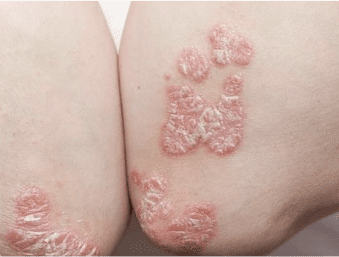
Psoriasis: The image above shows typical psoriasis. Note the defined border, silvery scaly appearance to the lesion and the location on the back of the elbow.
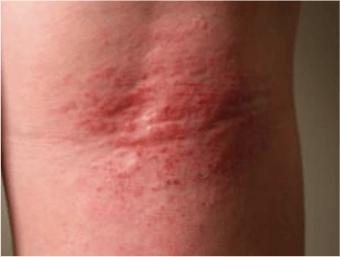
Eczema: The image above shows typical eczema. Note the lack of a clear border, the inflamed red appearance and location at the crease of the elbow.
Most moisturising creams/lotions/ointments are safe during pregnancy. You should always read the label to check for each cream but these do not tend to contain anything harmful for your baby.
Here are some examples of pregnancy safe emollients we stock: Doublebase gel; Dermol lotion; Epaderm Ointment, E45 Cream and many more.
Steroid creams are also generally considered safe to use during pregnancy however you should try to avoid using potent steroids during pregnancy as there is more theoretical risk of the cream being absorbed into the bloodstream. The lowest strength cream required to treat your eczema is best. If you are pregnant and requesting medication from us, make sure to make a note of this on your request so we can advise accordingly.
While these medications are safe when breastfeeding you should avoid applying to the breast directly before breastfeeding to avoid the baby ingesting any cream.
Eczema is not contagious and does not spread from person to person. When you are having an eczema flare it can become larger and seem to spread for a variety of reasons. This can be caused by irritation due to itching or exposure to an allergen (substance you are allergic to). It could also happen if the skin has become infected. If you are concerned about your eczema spreading try one of our treatments or book an appointment with one of our clinicians
Sadly there is no catch all cure for eczema however with the right creams and treatments lots of people can get their eczema under control and stop it impacting their lives. We’ve helped lots of people do this at DigiDerm and would love to help you do the same.




